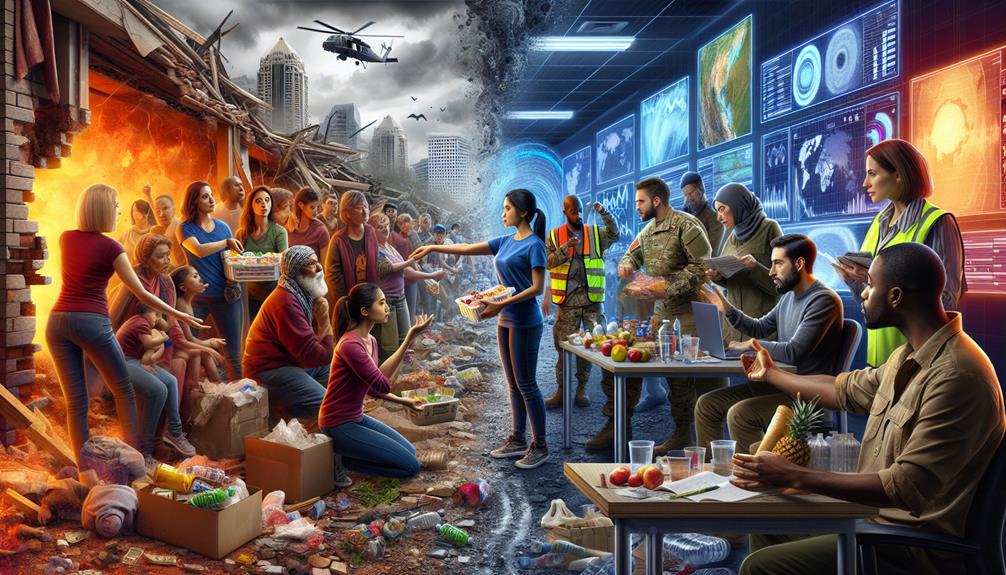When you consider the terms ‘disaster relief‘ and ‘disaster management,’ you might initially think they’re interchangeable, but there are critical distinctions between them. Disaster relief is your immediate action after a crisis hits, focusing on urgent needs like food, water, and shelter. Conversely, disaster management involves the strategies and preparations undertaken long before any disaster strikes. It’s about planning and organizing resources to effectively manage and mitigate the effects of potential future disasters. Understanding these differences can greatly enhance how you perceive and potentially engage with the processes during and after a disaster. What implications might these differences have on actual disaster scenarios?
Importance of Disaster Relief and Management
You’ll recognize the essential role of disaster relief in crisis situations as it provides immediate aid and resources, mitigating further harm.
Understanding the significance of disaster management strategies is vital, as it involves planning and preparedness to handle disasters efficiently.
Coordination and communication in disaster scenarios are imperative for aligning efforts and ensuring effective response across various agencies and stakeholders.
Role of Disaster Relief in Crisis Situations
You must understand that disaster relief plays a critical role in the immediate aftermath of a crisis. It guarantees the rapid distribution of aid, addressing urgent needs such as food, water, and shelter.
This function is pivotal in stabilizing affected communities and paving the way for recovery and management efforts.
Immediate response and aid distribution
Immediate response and aid distribution are crucial in stabilizing disaster-stricken areas by quickly addressing the basic needs of affected populations. You’ll see that efficiency in these operations can greatly reduce mortality rates and mitigate suffering.
This phase demands rapid assessment, precise resource allocation, and effective communication. Your understanding of these elements guarantees that relief efforts aren’t just timely but also appropriately targeted and executed.
Significance of Disaster Management Strategies
You’ll find that effective disaster management hinges on robust preparedness and meticulous risk assessment.
By understanding potential hazards and evaluating risks, you can create strategies that mitigate damage and save lives.
This approach not only prepares communities for immediate response but also supports sustainable recovery efforts.
Preparedness and risk assessment
Evaluating risks and preparing accordingly are critical components of effective disaster management strategies. You’ll need to systematically assess potential hazards and vulnerabilities that could impact your community.
This approach guarantees you’re not caught off guard. By identifying risks early, you can develop targeted strategies that mitigate damage and facilitate quicker recovery. It’s about being proactive rather than reactive, optimizing resources for maximum safety and efficiency.
Coordination and communication in disaster scenarios
Why is effective coordination and communication pivotal in managing disaster scenarios?
When you’re dealing with a disaster, whether it’s natural or man-made, the ability to synchronize the efforts of various agencies and organizations can mean the difference between chaos and stability. Coordinated efforts guarantee that resources aren’t wasted and that the responses are timely and efficient.
Communication, on the other hand, is the backbone of this coordination. It’s not just about passing information, but ensuring that it’s accurate, timely, and accessible to all involved parties.
Consider this: if rescue teams don’t know where to go, or if hospitals aren’t informed about incoming casualties, the result can be needless duplication of efforts and critical delays. Effective communication channels cut through this confusion, streamline operations, and can save lives by speeding up response times.
You’ll find that when everyone’s on the same page, decisions are made faster and they’re based on detailed, shared information.
Moreover, in the aftermath of a disaster, clear communication helps in the recovery process, facilitating a smoother shift from emergency response to long-term rehabilitation. It’s not just about managing the disaster; it’s about managing the aftermath, which often determines how quickly a community can start to rebuild and heal.
Challenges in Disaster Relief and Management
You often face significant hurdles in disaster relief and management, starting with resource allocation issues. The challenge isn’t just in securing enough resources; it’s also about distributing them where they’re most needed efficiently and swiftly.
Additionally, technological limitations can hinder your disaster response, affecting communication and coordination efforts important during crises.
Resource Allocation Issues
You face significant challenges when you try to optimize resource distribution in disaster relief and management. Efficient allocation guarantees maximum impact, yet it’s often hindered by logistical complexities and limited availability.
You must assess needs accurately and prioritize resources accordingly to enhance the effectiveness of your response.
Optimizing resource distribution for maximum impact
Addressing resource allocation challenges, disaster relief and management must strategically distribute aid to maximize impact. You’ll analyze needs, prioritize critical zones, and deploy resources efficiently.
It’s essential you understand local contexts to tailor responses. Centralized databases and real-time communication enhance your decisions, ensuring that aid reaches those most in need swiftly and effectively, thereby minimizing wastage and optimizing outcomes in disaster-stricken areas.
Technological Limitations in Disaster Response
You’ll encounter significant hurdles when trying to implement drones and AI in disaster management. These technologies, while promising, often face challenges related to compatibility with existing systems and regulatory constraints.
Additionally, the reliability of AI predictions and drone operations can be compromised under severe disaster conditions.
Utilizing drones and AI for efficient disaster management
Drones and AI enhance disaster management efficiency, yet they face significant technological challenges.
You’ll find that battery life limitations restrict operational duration, hindering sustained efforts. Additionally, data processing capabilities can be inadequate, delaying vital decision-making. Furthermore, integration issues with existing systems often complicate coordination.
It’s imperative to address these barriers to fully leverage drone and AI technologies in enhancing response strategies and improving outcomes in disaster scenarios.
Community Engagement in Disaster Response
You’ll find that community engagement in disaster response hinges greatly on local involvement.
By fostering education and training initiatives, you guarantee that residents aren’t just prepared, but are active contributors to managing crises effectively.
Such strategies not only boost resilience but also optimize the overall efficacy of disaster management systems.
Importance of Local Involvement
You’ll find that empowering local communities enhances disaster resilience to a great extent.
By involving residents in planning and response efforts, you tap into invaluable local knowledge and resources.
This approach not only speeds up recovery processes but also builds a stronger, more prepared community base for future emergencies.
Empowering communities for better disaster resilience
Empowering communities to actively participate in disaster response not only enhances resilience but also guarantees more effective recovery efforts. When you involve locals, they bring invaluable knowledge and expertise, essential for tailoring solutions to specific community needs.
This local involvement guarantees a faster, culturally sensitive response, maximizing resource use and minimizing recovery time. Truly, local empowerment is pivotal in transforming disaster management practices.
Education and Training Initiatives
You’ll find that education and training initiatives are integral to disaster management.
By implementing educational campaigns, awareness among the public increases, leading to more effective and coordinated responses during disasters.
These initiatives equip you with the knowledge and skills necessary to handle potential crises efficiently.
Enhancing public awareness through educational campaigns
Educational campaigns play a pivotal role in enhancing public awareness about disaster response efforts. By engaging you directly, these initiatives equip you with vital knowledge and preparedness strategies.
You’ll understand risks, response protocols, and recovery processes. This methodical approach guarantees you’re not just aware, but also proactive in disaster scenarios.
Effective education leads to informed decisions, ultimately minimizing the impact of disasters on communities.
Future Trends in Disaster Relief Articles
When examining the evolution of disaster relief, it’s crucial to acknowledge how the integration of big data and predictive analytics can improve response strategies. These technological tools play a key role in forecasting disaster impacts and enhancing resource allocation.
Moreover, responding to climate change requires innovative approaches in disaster relief, prompting a transition towards sustainable and resilient practices.
Integration of Big Data and Predictive Analytics
You’ll find that leveraging big data optimizes early warning systems by analyzing trends and patterns that predict disaster events.
This approach enhances your disaster response plans, making them more timely and effective.
Leveraging data for early warning systems and response planning
Integrating big data and predictive analytics greatly enhances the efficacy of early warning systems and response planning in disaster management.
You’ll harness vast amounts of data, swiftly analyzing them to predict and mitigate the impacts of disasters more effectively.
This approach not only saves lives but also optimizes resource allocation, ensuring that help is directed where it’s most critically needed, precisely when it’s required.
Climate Change Adaptation Strategies
Recognize the importance of climate change significantly amplifying the frequency and intensity of disasters.
When exploring climate change adaptation strategies, consider how these adjustments can help alleviate the escalating risks.
Integrating sustainable practices into disaster management protocols is crucial to effectively address these growing challenges.
Addressing the impact of climate change on disaster frequency and intensity
As climate change escalates, disasters are becoming more frequent and intense, necessitating advanced adaptation strategies in disaster relief efforts.
You’ll need to integrate robust forecasting tools and enhance early warning systems.
Investing in resilient infrastructure and community training is vital.
Adapting policies to prioritize sustainability and rapid response will mitigate impacts effectively.
These steps are essential for reducing vulnerabilities and improving disaster preparedness in changing climates.




